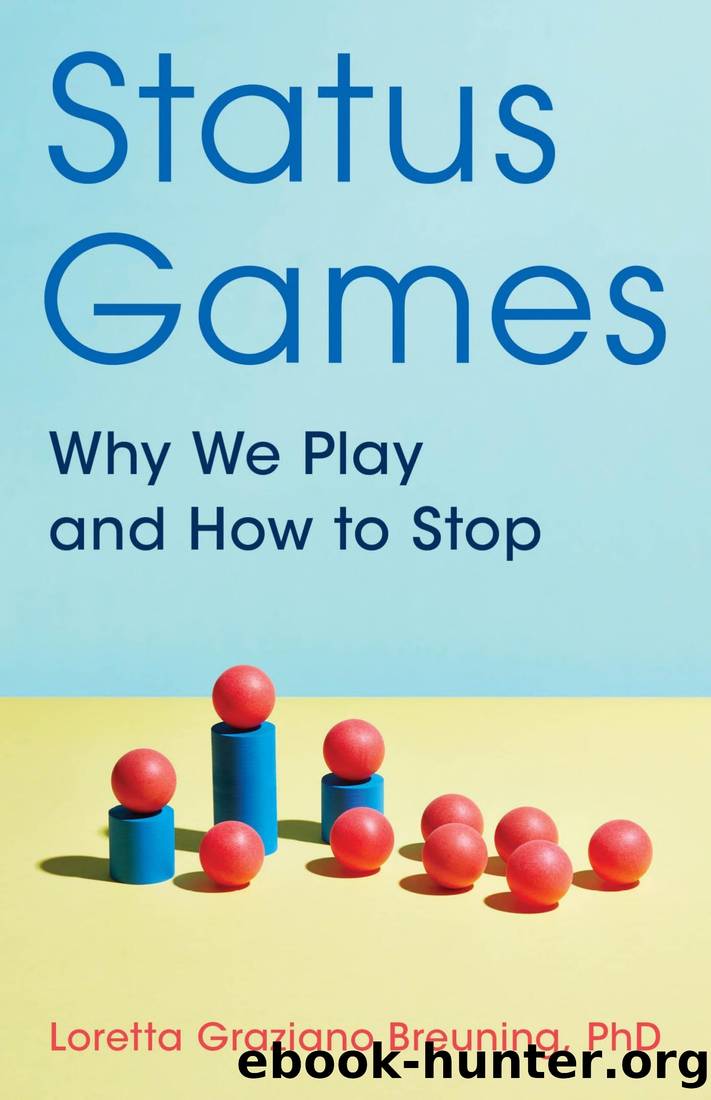Status Games: Why We Play and How to Stop by Loretta Graziano Breuning

Author:Loretta Graziano Breuning
Language: eng
Format: azw3, mobi
Tags: Mental Health, Psychology, Success, Emotions, Self-Help, Personal Growth, Happiness, Self-Esteem
ISBN: 9781538144190
Publisher: Rowman & Littlefield
Published: 2021-09-07T21:00:00+00:00
SEROTONIN VS. DOPAMINE, OXYTOCIN, AND ENDORPHIN
The good feeling of serotonin is different from the good feeling of dopamine, oxytocin, or endorphin. Nature gave us different reward chemicals to motivate us to meet different survival needs. We want all of them. Knowing the difference helps us understand status games.
Dopamine is the joy of meeting a need. If you are hungry and see food in the distance, your dopamine surges. You feel excited and energized to approach the reward. If your belly is full, other rewards get your attention. Your big human cortex can anticipate future threats to your resources. You look for ways to relieve potential threats, and when you find something, dopamine is your reward.
Oxytocin is the good feeling of social trust. Mammals seek safety in numbers because it promotes survival. Oxytocin is the good feeling that itâs safe to lower your guard. But sticking with the herd is frustrating, and a mammal would rather wander off to greener pasture sometimes. If it did, it would quickly be picked off by predators, so natural selection built a brain that rewards you with the good feeling of oxytocin when you stick with the herd. When youâre isolated, your oxytocin falls, and you start to feel unsafe. When you return to the herd, oxytocin surges. This wires you to expect a good feeling from social support.
Endorphin means âendogenous morphine.â Itâs the bodyâs natural opioid, triggered by real physical pain. Endorphin masks pain with a euphoric feeling, which enables an injured animal to run to save its life. Endorphin evolved for emergencies only. We are not meant to inflict pain on ourselves to get it. We are meant to seek dopamine, serotonin, and oxytocin, but not to seek endorphin. People do seek it, of course. âRunnerâs highâ is the well-known example. Runners donât get high every time they run. They have to run to the point of pain.
Each of these chemicals has its own job to do, but they often work in combination. Letâs see how they combine with serotonin. Imagine that you do a specific task in the expectation of a promotion. Serotonin creates the expectation that a promotion will feel good, and dopamine creates the excitement you feel as you take steps to approach the reward. Imagine that you do a good deed for your loved ones. Your brain anticipates both the oxytocin of social acceptance and the serotonin of social importance. Imagine that youâre training for a marathon. Serotonin creates the expectation of enormous pride if you finish, which stimulates the dopamine that motivates your daily workouts, and in turn stimulates endorphin.
It would be nice to enjoy happy chemicals all the time, but our brain saves them for moments when survival action must be motivated.
Imagine a hungry monkey who sees a piece of fruit in the distance. Dopamine is triggered thanks to past experience, and the good feeling motivates pursuit. The dopamine stops as soon as the monkey gets the fruit because it has already done its job. The reward value of a piece of fruit depends on how hungry the monkey is and how scarce the fruit is.
Download
Status Games: Why We Play and How to Stop by Loretta Graziano Breuning.mobi
This site does not store any files on its server. We only index and link to content provided by other sites. Please contact the content providers to delete copyright contents if any and email us, we'll remove relevant links or contents immediately.
The Longevity Diet by Valter Longo(4446)
The Body: A Guide for Occupants by Bill Bryson(3802)
Ikigai by Héctor García & Francesc Miralles(3144)
Limitless by Jim Kwik(2620)
The Body by Bill Bryson(2222)
The Checklist Manifesto by Atul Gawande(2204)
Memory Rescue by Daniel G. Amen(1962)
What Color Is Your Parachute? 2015 by Richard N. Bolles(1929)
Becoming Myself by Irvin D. Yalom(1912)
Breath by James Nestor;(1763)
Fat for Fuel by Joseph Mercola(1694)
Memory Rescue: Supercharge Your Brain, Reverse Memory Loss, and Remember What Matters Most by Amen Dr. Daniel G(1571)
Awakening Your Ikigai by Ken Mogi(1462)
Weight Training by Thomas Baechle(1461)
50 After 50 by Maria Leonard Olsen(1375)
Starting Over (Sugar Creek Romance ) by Jordan Silver(1374)
1610396766 (N) by Jo Ann Jenkins(1298)
The Telomerase Revolution by Michael Fossel(1288)
Supernormal: The Untold Story of Adversity and Resilience by Jay Meg(1251)
